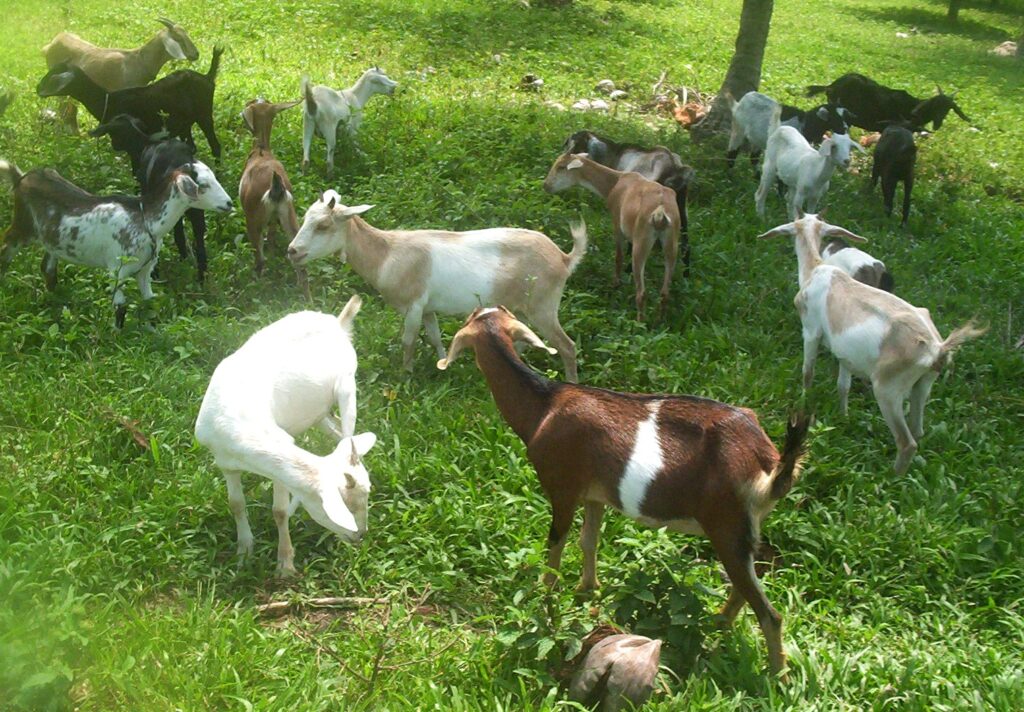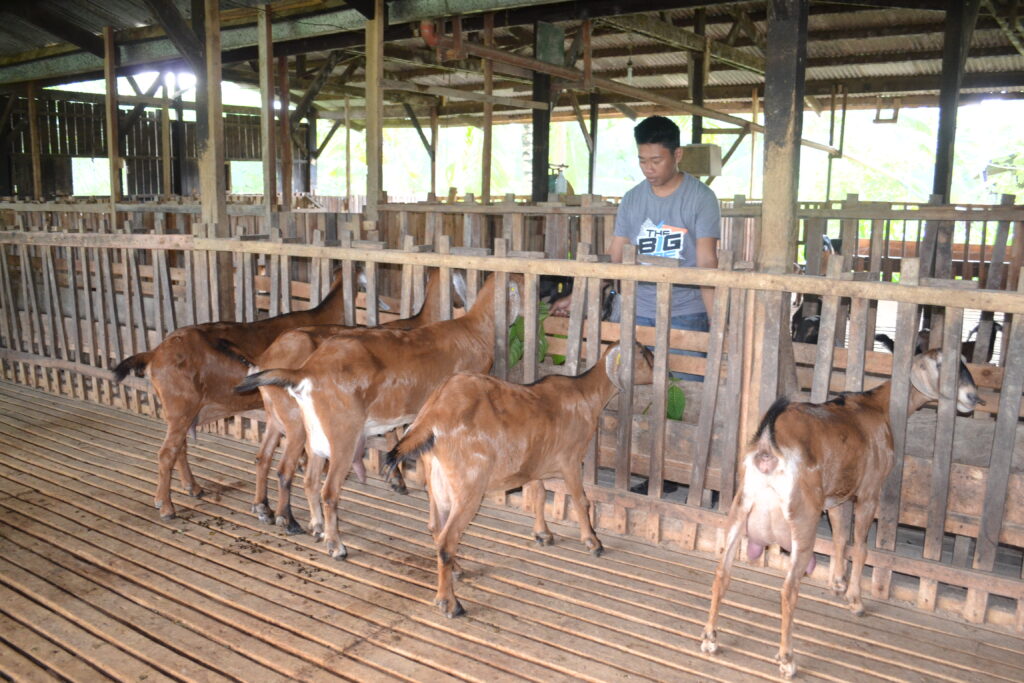Text and Photos by Henrylito D. Tacio
Can goats breed all year round – even during those months when they are not “in heat”? Is it possible to do so even without using chemical hormones?
Yes, it is possible. And it can be done through “green” methods developed by researchers of the University of Southern Mindanao (USM) in Kabacan, North Cotabato.
“Goats are known to be seasonal breeders,” explained Dr. Carlito B. Sanchez, who headed the study. “They come to heat only during cool months when the day length is short. In the Philippines, this is usually between September to February. For goats to give kids year-round, they need to be ‘in heat’ even during summer.”
Experts call this “out-of-season” breeding. “This kind of breeding is of interest to both dairy and slaughter goat owners because it reduces seasonal fluctuations in the herd’s milk and meat production,” he said.
Because of this, the USM researchers came up with alternative off-season “green” solutions in manipulating estrus in goats. Estrus is the period of sexual excitement at which time the female accepts the mating with the male.
“Such methods sit well with the Halal system of goat production under which use of chemical hormones is not acceptable,” Dr. Sanchez said. Among the Muslims, unnatural breeding of goats is considered “haram.”
“Green solutions ensure sustainability of production to cater to the needs of Muslim Filipinos, especially during festivities like Eid’l Fitr and Eid’l Adha,” Dr. Sanchez said.

The USM researchers have developed three “green” methods in estrus synchronization or heat induction in goats: photoperiodism or light effect, male/buck effect, and dormitory effect.
The goats are kept under natural photoperiod. Their nutritional levels are adjusted to meet maintenance requirements. The goats are allowed to graze during the day if the climatic condition is favorable. In addition, they are given free access to water and mineral blocks. At night, they are confined.
The goats for breeding are identified by placing ear tags or neck tags. Herding is done daily at around 10 am. At 6 pm., they are brought back to their pens.
“Strategic deworming is followed with the first dose given a month before the onset of the rainy season and succeeding dose given as the fecal egg count exceeds 100 eggs per gram in mixed infection,” Dr. Sanchez said. “Ivermectin injection is also given to the animals to control external parasitism.”
The estrus activity in goats is observed three times a day: at 5 am, 12 pm, and 6 pm with one-hour observation for each period. “Doelings that exhibit a tail-flagging response and stand for mounting are considered to be in estrus,” Dr. Sanchez said.
According to Dr. Sanchez, the light effect method consists of controlling exposure to daylight to mimic short-day periods. Does are confined in pens where they encounter a shorter period of exposure to light.
“As most goat breeds are photosensitive with respect to reproduction, the likelihood of their breeding is strongly influenced by how long or how short the days are,” Dr. Sanchez explained.
Goats are described as short-day breeders. “This means that the doe shows evidence of desire to breed when day length grows shorter,” he surmised. “A long day photoperiod consists of 16 to 18 hours of light exposure. In contrast, a short day photoperiod is characterized by eight hours of light followed by 16 hours of darkness.”
To maintain good health, the goats are housed in a building with adequate ventilation and regular cleaning. The pens are covered with plastic curtains from 4 am to 8 am to achieve the effect of light. “This gives a total darkness of 14 to 10 hours,” Dr. Sanchez said, adding that in this method, the duration of estrus from the onset of behavioral estrus to standing estrus among goats ranges from 12 to 14.6 hours. The duration of behavioral estrus from standing estrus to the end of estrus ranges from 14.5 to 19.83 hours.
“Overall, the total estrus period ranges from 27 to 34 hours,” he said. “The number of days to breed is from 10.25 to 21.5 days and the conception rate is from 66.67% to 100%.”
The second method – the male/buck effect – requires a minimal amount of labor and cost, according to Dr. Sanchez.
“The initiation of behavioral estrus in the doe is triggered by olfactory, behavioral and visual stimuli which result in ovulation of does,” he said. As such, “activities around the doe perceived by her brain can trigger excitement in the does affecting estrus. These include exuberant vocal expression of the buck and the odor emitted by the buck through its musk glands located behind the horn area that secretes strong odors.”
In this method, the bucks are isolated for three weeks before they are allowed to join the does. “The buck joins the herd of female goats for 12 hours each day,” Dr. Sanchez said.
This method shows the duration of estrus from the start of behavioral up to the standing estrus from six to 12.5 hours. On the other hand, the duration of behavioral estrus from standing estrus to the end of estrus is from 11.5 to 13.88 hours. All in all, the estrus period ranges from 17.5 to 26.38 hours.

The number of days to breeding is from 5.66 to 16.67 days, while the conception rate is from 83.33% to 100%, Dr. Sanchez said.
In the third method – the dormitory affect – social interactions play an important role in estrus induction among goats. “When does start cycling, the anestrous group will start to cycle too,” Dr. Sanchez said. “Rest may respond within 14.5 to 33.5 days and the conception rate is from 50% to 100%. The minimum number of keeping goats that can induce estrus is two heads of does.”
All over the country, more and more farmers are now raising goats. And this out-of-season natural breeding will definitely help those goat farmers. This means more income for them.
“They may be known as ‘poor man’s cow,’ but goats can be farmers’ source of income should there be crop failure,” points out Jethro P. Adang, the director of the Mindanao Baptist Rural Life Center (MBRLC) based in Kinuskusan, Bansalan, Davao del Sur.
Goats have been raised since time immemorial. David Mackenzie, in his book Goat Husbandry, wrote: “When man began his farming operations in the dawn of history, the goat was the kingpin of the personal life, making possible the conquest of desert and mountain and the occupation of the fertile land that lay beyond. The first of Man’s domestic animals to colonize the wilderness, the goat is the last to abandon the deserts that man leaves behind him.”

